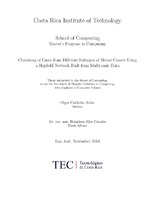Mostrar el registro sencillo del ítem
Clustering of Cases from Di erent Subtypes of Breast Cancer Using a Hop eld Network Built from Multi-omic Data
| dc.contributor.advisor | Dr. rer. nat. Francisco Siles Canales | es |
| dc.contributor.author | Calderón-Achío, Olger Kitchion | |
| dc.date.accessioned | 2019-02-18T14:49:06Z | |
| dc.date.available | 2019-02-18T14:49:06Z | |
| dc.date.issued | 2018 | |
| dc.identifier.uri | https://hdl.handle.net/2238/10344 | |
| dc.description | Proyecto de Graduación (Maestría en Computación) Instituto Tecnológico de Costa Rica, Escuela de Ingeniería en Computación, 2018. | es |
| dc.description.abstract | Despite scienti c advances, breast cancer still constitutes a worldwide major cause of death among women. Given the great heterogeneity between cases, distinct classi cation schemes have emerged. The intrinsic molecular subtype classi cation (luminal A, luminal B, HER2- enriched and basal-like) accounts for the molecular characteristics and prognosis of tumors, which provides valuable input for taking optimal treatment actions. Also, recent advancements in molecular biology have provided scientists with high quality and diversity of omiclike data, opening up the possibility of creating computational models for improving and validating current subtyping systems. On this study, a Hop eld Network model for breast cancer subtyping and characterization was created using data from The Cancer Genome Atlas repository. Novel aspects include the usage of the network as a clustering mechanism and the integrated use of several molecular types of data (gene mRNA expression, miRNA expression and copy number variation). The results showed clustering capabilities for the network, but even so, trying to derive a biological model from a Hop eld Network might be di cult given the mirror attractor phenomena (every cluster might end up with an opposite). As a methodological aspect, Hop eld was compared with kmeans and OPTICS clustering algorithms. The last one, surprisingly, hints at the possibility of creating a high precision model that di erentiates between luminal, HER2-enriched and basal samples using only 10 genes. The normalization procedure of dividing gene expression values by their corresponding gene copy number appears to have contributed to the results. This opens up the possibility of exploring these kind of prediction models for implementing diagnostic tests at a lower cost. | es |
| dc.language.iso | spa | es |
| dc.publisher | Instituto Tecnológico de Costa Rica | es |
| dc.rights | acceso abierto | es |
| dc.subject | Cáncer | es |
| dc.subject | Redes neuronales | es |
| dc.subject | Aprendizaje de máquinas | es |
| dc.subject | Reconocimiento de patrones | es |
| dc.subject | Bioinformática | es |
| dc.subject | Research Subject Categories::TECHNOLOGY::Information technology::Computer science::Computer science | es |
| dc.title | Clustering of Cases from Di erent Subtypes of Breast Cancer Using a Hop eld Network Built from Multi-omic Data | es |
| dc.type | tesis de maestría | es |
Ficheros en el ítem
Este ítem aparece en la(s) siguiente(s) colección(ones)
-
Maestría en Computación [119]


